|
As Above - Wetlands Wisdom
Process: this spray painted mural was commissioned by th New Hampshire Arts Council for the Lakes Region Community College in Laconia NH. I created the artwork using the plants and trees native to the New Hampshire region. These timeless images of the natural world were designed reflect the themes of Learning, Inspiration, Opportunity, Healthcare, and the Regional Environment. For a key to the plants used, check out the GRAPHIC in thenext page.
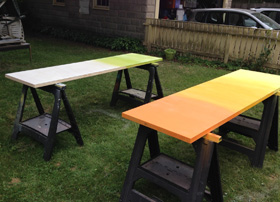
May: Color samples are created. I start by painting 2 full size hollow core doors with back ground color
|
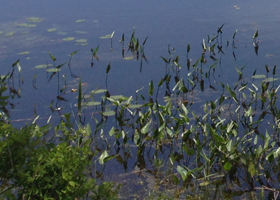
A expedition to the Ware River. High Bush Blueberry, Black Alder, Pickerelweed, Bull Rushes, Lily Pads, White Pine, Oak, and Cattails are collected.
|
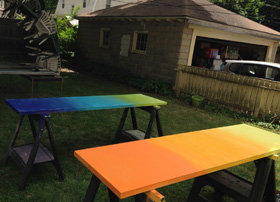
Painting with the plants begins. High winds and feral cats cause me to move the painting operation into the garage. |
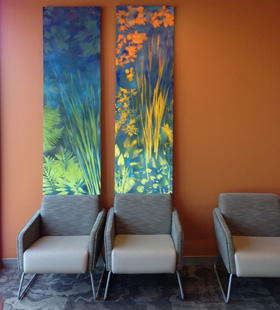
June 10: The finished color tests are loaded into the car and taken to Lakes Region Community College in Laconia NH. Tthe one on the RIGHT was selected.
|

June 13-25: The doors are a little too long for the space, due to the presence of chairs, so we agree that the final art will be shortened from 80 inches to 76 inches. A set of birch ply hollow core doors are cut down and reglued in my sister's wood shop.
|
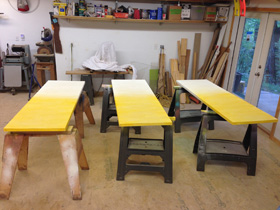 The 3 doors are primed with 2 cans each of Montana White Spray paint. This is done to seal the wood and keep it from lifting when dampened by the plant materials and paint. The 3 doors are primed with 2 cans each of Montana White Spray paint. This is done to seal the wood and keep it from lifting when dampened by the plant materials and paint.
|
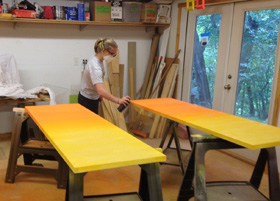 A background coat of 5 colors is sprayed on the doors, using the color test panel as the guide. A background coat of 5 colors is sprayed on the doors, using the color test panel as the guide.
|
 My art-intern for the month is my neice Kelsey. She ovecame her dislike of spiders to collect Lily Pads and Pickerelweed. Our motto: "Collect no ticks or poison ivy," and we succeed in that. My art-intern for the month is my neice Kelsey. She ovecame her dislike of spiders to collect Lily Pads and Pickerelweed. Our motto: "Collect no ticks or poison ivy," and we succeed in that.
|
 The plant materials are carefully arranged on the panels. It takes time, as the background layer of paint is sensitve to scuffing. The plant materials are carefully arranged on the panels. It takes time, as the background layer of paint is sensitve to scuffing.
|
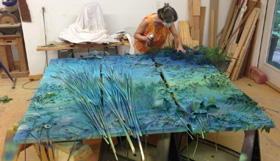 At last,painting the plant layer begins! It takes several days, and roughly 10 differnt layers of paint to achieve the 3 dimensional effects I am after. It is like slowly developing a photograph. At last,painting the plant layer begins! It takes several days, and roughly 10 differnt layers of paint to achieve the 3 dimensional effects I am after. It is like slowly developing a photograph.
|
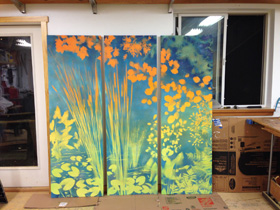 June 18: The big reveal! Theplant material was removed carefully so as not to scuff or scrape the tender layers of paint. June 18: The big reveal! Theplant material was removed carefully so as not to scuff or scrape the tender layers of paint.
|
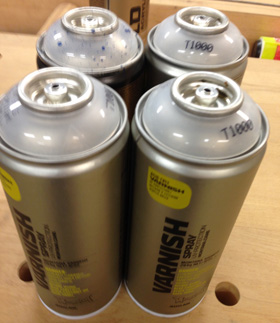 June 20-25: the picky part. Kelsey and I use tweezers to remove edges of leaves, fern spores, bugs and cattail fuzz from roughly 70 SQ FT of painting. Each panel is coated with 3-5 cans of Montana Spray Varnish. June 20-25: the picky part. Kelsey and I use tweezers to remove edges of leaves, fern spores, bugs and cattail fuzz from roughly 70 SQ FT of painting. Each panel is coated with 3-5 cans of Montana Spray Varnish.
|
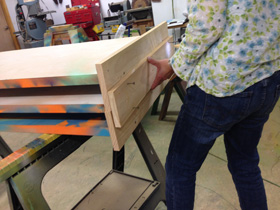 June 25: the finished paintings are cleated together and put in the van to transport to New Hampshire. June 25: the finished paintings are cleated together and put in the van to transport to New Hampshire.
|
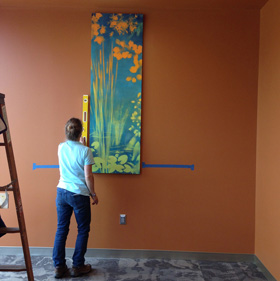 June29: Installation Day! Careful measuring first, by Lee Bares, who is a Civil Engineer. June29: Installation Day! Careful measuring first, by Lee Bares, who is a Civil Engineer.
|
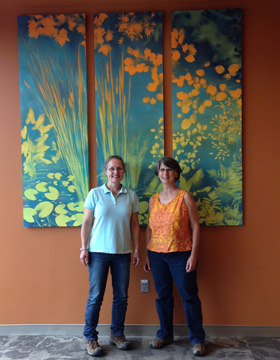 And the final result - a happy installation team and beautiful artwork on the wall. And the final result - a happy installation team and beautiful artwork on the wall.
|
|
|
|
|






 The 3 doors are primed with 2 cans each of Montana White Spray paint. This is done to seal the wood and keep it from lifting when dampened by the plant materials and paint.
The 3 doors are primed with 2 cans each of Montana White Spray paint. This is done to seal the wood and keep it from lifting when dampened by the plant materials and paint. A background coat of 5 colors is sprayed on the doors, using the color test panel as the guide.
A background coat of 5 colors is sprayed on the doors, using the color test panel as the guide. My art-intern for the month is my neice Kelsey. She ovecame her dislike of spiders to collect Lily Pads and Pickerelweed. Our motto: "Collect no ticks or poison ivy," and we succeed in that.
My art-intern for the month is my neice Kelsey. She ovecame her dislike of spiders to collect Lily Pads and Pickerelweed. Our motto: "Collect no ticks or poison ivy," and we succeed in that. The plant materials are carefully arranged on the panels. It takes time, as the background layer of paint is sensitve to scuffing.
The plant materials are carefully arranged on the panels. It takes time, as the background layer of paint is sensitve to scuffing. At last,painting the plant layer begins! It takes several days, and roughly 10 differnt layers of paint to achieve the 3 dimensional effects I am after. It is like slowly developing a photograph.
At last,painting the plant layer begins! It takes several days, and roughly 10 differnt layers of paint to achieve the 3 dimensional effects I am after. It is like slowly developing a photograph. June 18: The big reveal! Theplant material was removed carefully so as not to scuff or scrape the tender layers of paint.
June 18: The big reveal! Theplant material was removed carefully so as not to scuff or scrape the tender layers of paint. June 20-25: the picky part. Kelsey and I use tweezers to remove edges of leaves, fern spores, bugs and cattail fuzz from roughly 70 SQ FT of painting. Each panel is coated with 3-5 cans of Montana Spray Varnish.
June 20-25: the picky part. Kelsey and I use tweezers to remove edges of leaves, fern spores, bugs and cattail fuzz from roughly 70 SQ FT of painting. Each panel is coated with 3-5 cans of Montana Spray Varnish. June 25: the finished paintings are cleated together and put in the van to transport to New Hampshire.
June 25: the finished paintings are cleated together and put in the van to transport to New Hampshire. June29: Installation Day! Careful measuring first, by Lee Bares, who is a Civil Engineer.
June29: Installation Day! Careful measuring first, by Lee Bares, who is a Civil Engineer. And the final result - a happy installation team and beautiful artwork on the wall.
And the final result - a happy installation team and beautiful artwork on the wall.